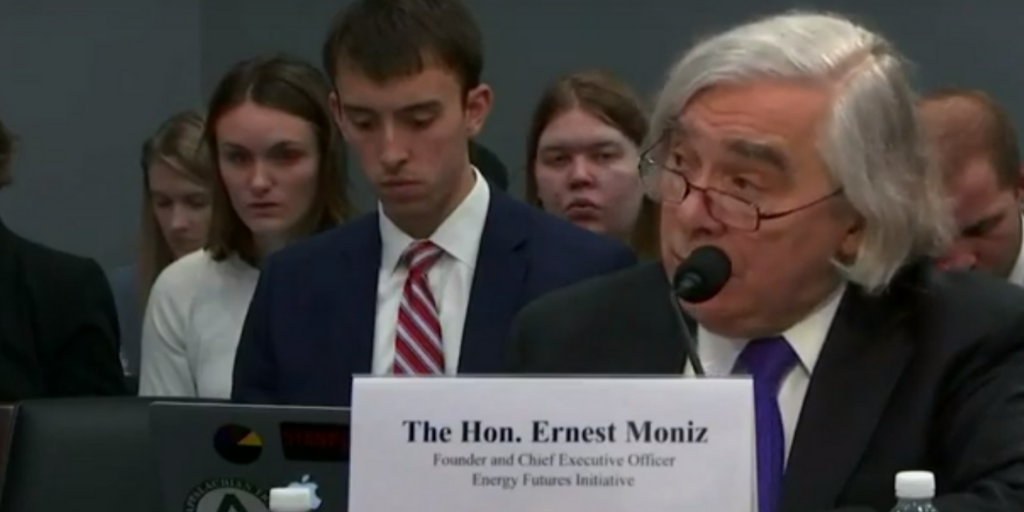November 27, 2019
Funding an Energy Transition
Posted by Kasia Kornecki

As appropriators are still trying to finalize the 2020 budget, the House Appropriations Subcommittee on Energy and Water Development sat down last week for a hearing about the DOE’s role in addressing climate change. The main thematic questions of the hearing were: What technologies will help move us into the future sustainably, and how can DOE facilitate the energy transition? This lively and lengthy hearing made a strong case for not hedging our bets on any single energy solution. Dr. Ernest Moniz, former Secretary of Energy and current CEO of the Energy Futures Initiative, touched on a multitude of programs housed at DOE, ranging from advanced nuclear, to advanced geothermal, wind, solar, and low-carbon liquid fuels. Despite the assortment of deployable zero- and low-carbon technologies covered in DOE’s portfolio, Moniz notes that the “scale and pace needs to be much greater.”
Moniz is the author of the “Green Real Deal (GRD),” a practical guide for planning the energy transition, and not just at the technological level. The GRD addresses issues of the actual costs of deep decarbonization, including possible inequities in carbon pricing, and job loss in certain economic sectors. A theme of the GRD is that no single technology is a silver bullet, and that different solutions are necessary for different sectors of the economy, as well as different regions. Due to the sustained need for investment in research and deployment, the GRD has provisions for a special funding mechanism that could sidestep financial slowdowns, like those caused by continuing resolutions.
Vi Lyles, the Mayor of Charlotte, NC was also a witness. She noted that working at the local level is a concrete way to reduce emissions. Investments in retrofitting buildings with energy efficient features, resilient infrastructure, and carbon-free mass transit will help cities achieve their climate targets. Getting DOE to collaborate with stakeholders at the local level could be part of a strategy to strengthen the reach of new sustainability solutions. Chairwoman Kaptur (D-OH) agreed that DOE’s efforts are not currently organized regionally, and that moving forward, DOE could strive to recognize local differences in energy resources and provide a clean energy “template that people can buy into at every level.”
Rep. Pocan (D-WI) wanted to know what new sustainability solutions could use the biggest funding boost. The witnesses agreed in three main areas of underinvestment: carbon capture in the fossil sector, perovskite as a more efficient material for solar cells, and energy storage. Moniz reminded the committee, “Don’t equate ‘storage’ to just batteries.” Clean hydrogen, as well as other low-carbon liquid fuels, could be the storage medium of the future.
While the committee agreed that investment in clean technologies is going to be critical for sustainable progress, Ranking Member Rep. Simpson (R-ID) played the devil’s advocate and voiced concern about cross-agency duplicate efforts to address the same questions. Perhaps he was referring to DOE’s intention to allocate $13.5M to atmospheric research, or recent talk of creating an entirely separate agency to handle all climate-change related matters: the Government Accountability Office recently released a report supporting such a recommendation. The witnesses, however, kept their remarks strictly on DOE’s technology portfolio, noting how commercial wind and solar projects wouldn’t exist today without DOE programs.
Estimates vary, but minus the 9-20% of annual GHG emissions attributable to agriculture, all remaining emissions are directly related to how we create and use energy: in electricity, industrial processes, buildings, and transportation. Given another bleak emissions gap report released in late November by the UNEP, the time to invest heavily and urgently is now. All at the hearing were in agreement: massive investments in clean energy technology, storage, and deployment will pay off in the fight against rising global temperatures.
Kasia Kornecki is an intern for AGU’s Public Affairs team. She is a Ph.D. chemist and is interested in policy related to climate, clean energy, and sustainability.


[…] Fonte/Source: https://blogs.agu.org/thebridge/2019/11/27/funding-an-energy-transition/ […]